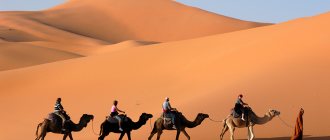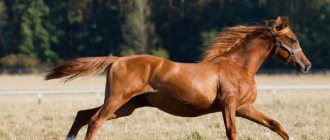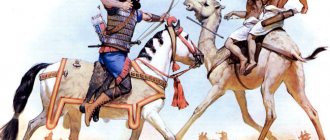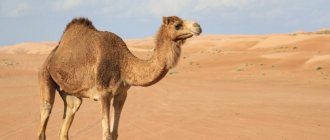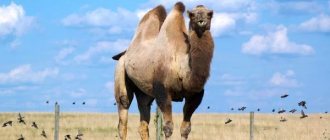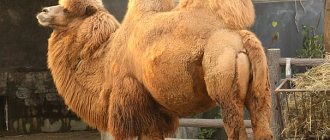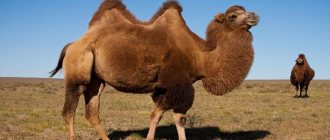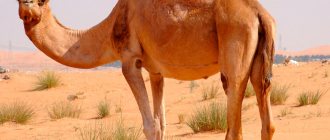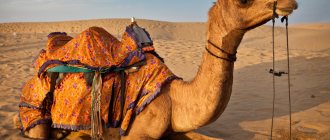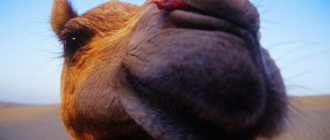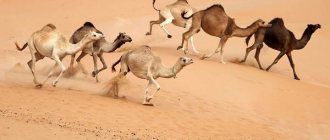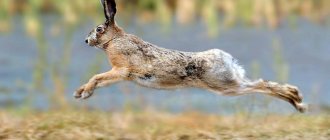A majestic ship “sails” among the sandy “mountains” of the desert... Who do you think we are talking about? Well, of course, about the camel. This animal has long been called exactly that – “ship of the desert.” And there is no longer an animal in the world that can endure the scorching sun, while carrying a heavy load. The two-humped and one-humped camels are truly unique animals of their kind.
Bactrian camel (Camelus bactrianus)
Characteristics and description of the animal
Scientists believe that the first ancestors of camels appeared about 25 million years ago. Their homeland is North America. Judging by the skeletal remains, about 3-4 million years ago the animals settled in Europe, and then penetrated into Asia and Africa, populating deserts and semi-deserts. In the process of evolution, they developed anatomical features of adaptation to their environment:
- the camel's toes do not form hooves, but feet with calluses and claws, providing increased stability on loose soil;
- thick fur protects against overheating and hypothermia during daily temperature changes in the desert;
- long eyelashes and narrow nostrils prevent sand from entering during sandstorms;
- calluses on the knees allow the animal to sink onto the hot sand while resting.
Man domesticated the camel around 3000 BC. At first, this pet was used exclusively for transporting goods. Adults are able to move a load whose weight is equal to half their own weight. Depending on the type, the load capacity can range from 250 to 400 kg.
From the end of the 2nd millennium BC. camels are beginning to be used as mounts. The first mention of warriors riding Mehari camels (a fast-moving variety) dates back to the 9th century BC. Subsequently, the Arab experience of using camels as fighting animals was successfully applied in the Roman army.
Lifestyle
Camels are sedentary animals. They do not change their habitat throughout their lives. Every day, herds travel within their ranges in search of food. During the hottest times, camels find shelter from the sun behind the slopes of dunes or in the shade of vegetation. At night, animals sleep, lying on their sides or on their legs tucked under them.
Before domestication, camels led a herd lifestyle, forming family groups of 30-50 individuals. The largest male played the dominant role in the herd. Currently, these animals are practically never found in the wild.
Camels move at a speed of 10 km/h; when running away from enemies or other danger, they can reach speeds of up to 30 km/h. The maximum speed that has been recorded during camel racing is 65 km/h.
What does it look like
The appearance of a camel has the following characteristic features:
- the body is dense, elongated;
- a medium-sized head with an elongated muzzle and small rounded ears, a long neck curved down;
- the eyes are large, black, and have an additional eyelid;
- the legs are long, slender, widening at the ends, forming a sole;
- the tail is short and ends in a tassel.
Traditional camel coat colors: cream, yellow-beige, light brown, reddish brown. Among Bactrians there are individuals with white fur.
How many years do they live
The average life expectancy of camels is 40-45 years. Reproductive age begins at 2-3 years. Animals are used to transport goods from 4 to 25 years of age.
Spreading
The modern distribution area of camels does not coincide with their place of origin. Thus, the dromedary (this is a one-humped camel) is mainly distributed in northern Africa and the Middle East, while the Bactrian is found in China, Mongolia, and Central Asia. Small herds of wild Bactrians are still found in remote, inaccessible areas of China and Mongolia. Unlike its closest relative, the dromedary is a completely domesticated species, and wild dromedary camels, not counting the re-wilded Australian ones, are not found in nature.
These animals were domesticated, according to scientists, approximately in the third millennium BC on the territory of the Arabian Peninsula.
Types of camels: names and photos
The classification distinguishes three currently existing species.
dromedary camel
Also known as dromedary, which means “fast camel” in ancient Greek. This is an elegant and slender animal, whose weight does not exceed 600-700 kg, and its height is 1.8 m. The dromedary's coat is relatively short, so the dromedary camel tolerates low temperatures less well.
Bactrian camel
The second common name for the animal is Bactrian. Researchers believe that its etymology is connected with the name of one of the territories in Central Asia: in their opinion, it was in Bactria that the first domesticated camels appeared.
The Bactrian camel has more impressive dimensions: the maximum weight of males reaches 800 kg, the height at the withers is 2.2 m, and with humps - 2.7 m. Bactrians, which are more hardy and resistant to temperature changes, are valued higher than their relatives.
Khaptagai
The wild Bactrian camel lives in the Gobi Desert, mainly in Mongolian territory. The number of haptagai has reached a critical level; they are included in the International Red Book with the status of “Endangered Species”.
Domesticated species living in different territories acquired certain external differences, which made it possible to distinguish several subspecies. Thus, among the Bactrians, the Mongolian, Kalmyk, Astrakhan, and Kazakh camels are distinguished.
Among the now extinct species, scientists identify 6 varieties, including western and dwarf camels. Arab legends mention a three-humped camel, but there is no scientific confirmation of the existence of such a species.
Hybrids
Farms involved in camel breeding are working to develop new breeds and hybrids with improved characteristics. Among the mestizos, the following varieties are of greatest interest:
| Hybrid name | Peculiarities |
| Nar | Bred as a result of crossing the Arvan and the Kazakh camel. Males weigh about a ton; the annual milk yield of females reaches 2 thousand liters of milk. |
| Kaspak | Meat-dairy hybrid obtained by crossing a Nara and a Bactrian camel |
| Kama | The offspring obtained from llamas and Bactrian camels have unique endurance. Animals are raised to transport goods in the most impassable areas of the Andes and other mountain ranges. |
| Kez-nar | Bred by crossing the Turkmen camel and the caspak. Raised on farms to produce camel meat and milk |
Desert ships
Camels are simply created for life in the desert! It is not for nothing that for many centuries they were the “ships of the desert” on which they transported cargo. Until now, no modern form of transport can compete with camels when it comes to conquering the desert.
In many countries the camel is a domestic animal, and in some it is sacred. These large and hardy mammals inspire admiration and respect. There are many legends and interesting facts about camels.
Despite their external attractiveness, they cannot be called handsome. But, nevertheless, the word “camel” translated from Arabic means “beauty”.
A competition is held annually in Abu Dhabi to choose the most beautiful camel. This takes into account not only appearance, but also behavior, breed, speed and much more. Winners increase in value. The most famous people buy them.
Many people are accustomed to believing that a camel needs a hump in order to store water in it. But this is a misconception. It contains fat that reduces high temperature throughout the body. In addition, it saves the animal from hunger.
It is also eaten by people. The hump contains a small amount of meat. It has a sour taste and is also slightly harsh, but among many people it is a delicacy and is not cheap.
Given the previous fact, an obvious question arises: why can camels go without water for quite a long time? The reason lies in the structure of their red blood cells.
Camels are the only animals that have oval-shaped red blood cells, allowing them to flow smoothly even after dehydration. For comparison, the red blood cells of people in a similar situation begin to collide.
The loss of even a quarter of the body's moisture is not dangerous for a camel, while for other mammals a loss of 15% is fatal. Thanks to this feature, camels are ideal animals for living in such difficult desert conditions.
Camels, like all living creatures, need rest. If the animal lies down to sleep or rest, then it is almost impossible to raise it to its feet.
We'll have to wait until he deigns to do it himself, otherwise you'll only anger him. When angry, a camel can spit, and not only with saliva.
The spit may contain some of the stomach contents, which smell very bad.
Despite the presence of humps, camels have straight spines, like all mammals. Their eyes are protected from sand and dust by long eyelashes, as well as a third eyelid.
Interesting facts about camels:
Kara-Kum candies are associated with a camel, which is depicted on the wrapper. In fact, in the Kara-Kum desert, nomadic Turkmens actually bred these animals, but they had one hump, and not two, as depicted on candy wrappers.
The flag of the Chelyabinsk region and the coat of arms of the city of Chelyabinsk itself are crowned with a camel. Why? After all, there are no camels in that area at all. It turns out that in the 19th century, Chelyabinsk, like many other cities, flourished due to trade, and a trade route ran through the city. Cargo was transported on camels. That's why people chose this animal as a symbol.
Many tribes in Kenya live in territories located far from civilization, in impassable places. Despite this, quite educated people live there. Mobile libraries were invented for them, and camels were the drivers, since this is the only way to “deliver” education to remote areas.
Camel milk is not only a tasty product, it is also used for cosmetic purposes. Masks are made from sour cream to protect the skin from sun rays and chapping.
Milk is also used for medical purposes to treat psoriasis, food allergies, and restore the immune system.
Today, Arab scientists are developing a formula for a drug based on camel milk against cancer.
Camels are truly unique and priceless animals. No wonder there is a legend that the stars in the sky are heavenly camels belonging to Allah.
Source: https://lubopitnie.ru/korabli-pustyini/
Where do they live?
Camels are common on the African continent (the most numerous populations live in Somalia, Egypt, Tunisia), in the countries of East and Central Asia (Afghanistan, Iran, Mongolia, Kazakhstan), and on the Arabian Peninsula.
In Australia
Camels were introduced to Australia in the late 19th century. The animals successfully adapted to new conditions. Currently, the population on the continent has exceeded 50 thousand individuals.
Where live
The natural habitat of camels is arid regions: deserts, semi-deserts, steppes. Animals tolerate heat and frost well, but they are not adapted to live in natural areas with high humidity and in mountainous areas.
What do they eat
Camels are unpretentious to food, and their fleshy, hard lips allow them to eat even vegetation that is not suitable for other herbivorous mammals. The basis of the diet is saxaul, solyanka, wormwood, camel thorn, sand acacia, and barnyard grass. After grazing, the camel regurgitates the swallowed vegetation and slowly chews it. The structural features of the digestive tract allow you to extract maximum benefit from the toughest and roughest food.
RHINOCEROS
How do they reproduce?
Puberty in camels occurs at the age of 2-3 years. Animals kept in captivity are allowed to mate only for 4-5 years. Camels mate in winter, during the rainy season.
Pregnancy lasts 13-14 months, depending on the breed, after which the female has one baby camel. He is ready to follow his mother 2-3 hours after birth. The camel feeds her baby with milk for up to 12-18 months. Even after the end of lactation, the female continues to look after him, protecting him from dangers.
Price
The speed of a camel dictates its price. Several thousand dollars can be paid for a good runner with an excellent pedigree. A camel with an excellent racing pedigree was sold in the United Arab Emirates for an incredible $910,000. He is a descendant of the famous Jabara, a multiple race winner.
Animals are valued not only for their speed. The world's most expensive camel of the Majahim breed was purchased at the camel beauty festival in 2008. The price of the beauty was one million two hundred thousand dollars. Dromedaries of this breed are not used for racing; they are valued for their dark (chocolate) coat color, slenderness, and graceful curve of the neck.
Why do camels spit?
For animals living in the wild, spitting at an opponent meant a threat and a warning of a possible attack. In this way, the camels tried to force the enemy to admit defeat without a fight. Domesticated animals sometimes spit at people, thus showing that human actions alarm or irritate them. Since camels have a fairly calm and balanced character, such a reaction to external stimuli is infrequent and justified.
PUMA
What's in a camel's humps?
It's time to get some food...
A characteristic feature of the animal is a growth on its back. Why does a camel need a hump and what is it made of? During periods when there is a sufficient amount of food on pastures and the camel feeds intensively, fatty deposits accumulate in the back growths. During long walks on sand, fat reserves are gradually consumed. Camel fat contains all the substances an animal needs. Thanks to the reserves stored on their backs, desert ships can go without food for about 3-4 weeks. By the location of the hump, you can determine the degree of exhaustion of the camel: if the growth is in a vertical position, the camel is full, if the hump is bent and drooping, the camel has been starving for a long time.
How long can a camel go without water?
All animals living in the harsh conditions of desert regions are adapted to a constant lack of moisture. However, in comparison with them, the camel is the real king of the desert. It can go without water for 10 days while using energy sparingly. With intense activity (running, carrying luggage), this period is halved.
This unique ability of camels is due to the behavior and structure of the body:
- animals lead an inactive lifestyle;
- moisture loss during life is minimized (steam settles as condensate inside the nostrils and flows into the esophagus; sweat glands begin to work only after body temperature rises to +40 degrees; in the alimentary tract, all the liquid contained in the vegetation is extracted from the green mass);
- The camel's body is able to accumulate nutrients and moisture and gradually consume them in the absence of food and drink.
MEERKAT
Nutritional Features
The dromedary camel is a herbivore and is capable of feeding on many types of plants, even thorny and salty ones. The food is swallowed practically without chewing; in this form it enters the anterior stomach, where digestion occurs.
Dromedary
The dromedary can live for a long time without drinking water (a week under a pack and months without load). The loss of fluid in its body can be up to 40% in volume, but the camel drinks very quickly, thereby compensating for the lost volume of fluid. In 10 minutes the animal can drink up to 100 liters of water. The dromedary's dorsal hump contains fat reserves that are gradually used for energy. Camels store liquid in their stomach.
Interesting facts about camels
- In many Arab countries (Saudi Arabia, Qatar, Oman, UAE) camel beauty contests are held. The price of the winning animals reaches truly prohibitive heights. Thus, one of the camels, presented at a competition in the United Arab Emirates, was purchased for 2.7 million dollars.
- The most numerous are the Arab camel caravans that transported goods across the Sahara in the 10th and 11th centuries. The number of camels in the lines moving through the desert reached 12-15 thousand.
- With a prolonged absence of water and food, a camel can lose about a quarter of its weight. Despite significant dehydration, the animal’s blood does not thicken. One reason is the oval shape of red blood cells.
- In the sacred books of many religions there is an expression: it is easier for a camel to go through the eye of a needle than for a rich man to enter heaven. It is believed that in this case the reference is not to an ordinary sewing needle, but to a small hole in the wall near the Gate of Judgment in Jerusalem. The opening into which a person of average build can hardly pass is called the eye of a needle.
- Camel farming is one of the most profitable branches of livestock farming. Animals are raised for meat, milk and wool. Dried camel dung is used as fuel for heating and cooking.
- Camels have keen eyesight and a well-developed sense of smell. They are able to determine the location of water at a distance of several tens of kilometers. Bedouins have used camels since ancient times when searching for places to dig wells.
Camel racing
After the oil boom and the rapid industrial development of the UAE, camels lost their relevance. The government of the country, wanting to preserve the original traditions of its people, paid special attention to camel racing. Today, about two dozen specially built camel racing facilities are in operation.
Numerous breeding farms breed animals, focusing their selection on the camel's speed. Training centers are open. Previously, children took part in the races as riders, but at the beginning of the century a law was passed prohibiting persons under 15 years of age from participating in competitions. “Weighting” the riders led to a decrease in the speed of the camel. A solution was found. Robots were placed on animals. The machines are controlled remotely. Owners are allowed to accompany animals along the route, shouting encouragement to them.
From 15 to 70 animals take part in one race. The distance can be from 4 to 10 km. Very strict age selection rules. Only those aged one to eight years old can compete, and there are no restrictions based on gender. Females run more often, they are easier to train and are not as stubborn as males.
The development of the camel racing industry is stimulated not only by the comprehensive support of the state. Sponsors are attracted, providing participants not only with millions in bonuses, but also with expensive gifts, cars, and collectible weapons. Owning a racing dromedary is considered prestigious, as Prince of Dubai Hamdan bin Mohammed bin Rashid al-Maktoum is among the camel breeders.
